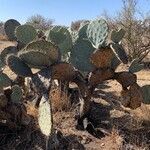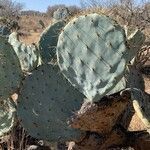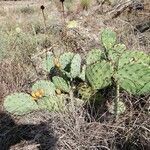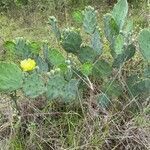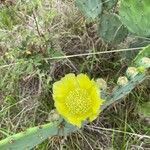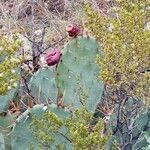Erect shrub 0.5–4 m high, to 4 m wide, trunk sometimes well-developed to 40 cm high. Stem segments firmly attached, obovate to orbicular, 14–42 cm long, 10–40 cm wide, 18–25 mm thick, compressed, smooth, green, yellow-green or glaucous blue-green, dull, glabrous. Areoles, 25–40 per stem segment face, distant, 17–40 mm apart, elliptic, suborbicular to orbicular, 4–10 mm long, 4–10 mm wide, with wool tan, ageing blackish. Leaves succulent, terete, narrowly conical, 3–9 mm long, caducous. Spines (0) 1–6 (–12) per areole, present in nearly all areoles or absent basal areoles, unequal, the longer spines spreading to strongly reflexed, 10–50 mm long, 0.7–1.0 mm wide at base, ± flexible to rigid, not barbed, very narrowly elliptic in cross-section or angular at least near base, straight to curved, white to yellow, usually red to dark brown at extreme bases, ageing grey to ± black. Glochids sparse to dense, in crescent at adaxial edge, encircling areole or nearly so, and scattered in subapical tuft, or throughout areole, of irregular length to 10 mm long, yellow, ageing brown or grey. Flowers 50–100 mm diam.; outer tepals greenish yellow, brownish green, margins yellowish, rarely wholly reddish, succulent, obovate, 6–35 mm long, 6–15 (–25) mm wide, the apex with a short mucro or acuminate; inner tepals yellow, or midrib orange near base, widely spreading, obovate to cuneate-obovate, 30–50 mm long, 12–25 (–40) mm wide, the apex obtuse with short mucro; staminal filaments yellow, green at base, anthers pale yellow; style greenish yellow to carmine, stigma lobes greenish yellow; pericarpel (at anthesis) not tuberculate, spineless. Fruit solitary, usually deciduous, ovoid to obovoid, 35–70 mm long, 25–40 mm diam., not tuberculate, umbilicus shallow, areoles scattered or toward apex, spineless, the fruit maturing to carmine, succulent and juicy. Seeds suborbicular to deltoid, flat 2.5–6 mm long, 2–5 pale brown.
More
Shrubs or trees, with short trunk , spreading to sometimes de-cumbent, 1-3 m. Stem segments not disarticulating, yellow-green to blue-green, flattened, circular to obovate to rhombic, or apex tapering, elongate, 15-40(-120) × 10-40 cm, ± tuberculate, gla-brous, often glaucous; areoles 5-8 per diagonal row across mid-stem segments, evenly distributed on stem segment to absent, subcircular to obovate, 4-7 × 4-6 mm; wool tawny, aging blackish. Spines (0-)1-6(-12) per areole, white to yellow, usually red to dark brown at extreme bases, aging gray to ± black, subulate, straight to curved, flattened to angular at least near base, the longest spreading to strongly reflexed, 10-30(-50) mm. Glochids widely spaced, sparse in crescent at adaxial edge, encircling areole or nearly so, and scattered in subapical tuft, yellow to red-brown, aging gray to blackish, of irregular lengths, to 10 mm. Flowers: inner tepals uniformly yellow to buff, sometimes orange to pink to red (rarely whitish), 30-40 mm; filaments, anthers, and style whitish to cream; stigma lobes yellow-green to green. Fruits dark red to purple throughout, sometimes stipitate, ovate-elongate to barrel-shaped, 35-90 × 20-40 mm, juicy (bleeding and staining), glabrous, spineless; areoles 20-32 usually toward apex. Seeds tan to grayish, subcircular to deltoid, flattened, 2.5-6 × 2-5 mm; girdle protruding 0.3-0.5 mm.
Shrub, 0.4-1.5 m high; ± erect to decumbent; trunk usually absent; cladodes orbicular or broadly obovate, 150-200 mm long, tuberculate, glabrous, often glaucous; areoles elliptic, 5-8 in a row diagonally across centre of cladode, hairs tawny, ageing blackish; glochidia large, yellow, becoming brown. Spines 1-3, sometimes absent from lower areoles, subulate, slightly flattened, mostly curved lying near stem surface, up to 40 mm long, yellow or paler, becoming brown or grey with age. Leaves minute, early deciduous. Flowers: 50-80 mm long; perianth yellow, rarely red; Oct.-Dec. Fruit obovoid or ellipsoid, 30-70 mm long, purple or red; pulp reddish purple, almost spineless.
Succulent, branched shrub, 1.0-1.5 m high. Cladodes flattened, orbicular to broadly obovate, 200 x 160 mm, glaucous-green; areoles widely spaced, raised, woolly, spines 1-3, up to 50 mm long, flattened, stout, curved, pale grey to yellow, mainly towards apex. Flowers yellow. Flowering time Oct.-Dec. Fruit obovoid, ± 70 mm long, purple, fairly smooth.
In Australia, Opuntia engelmannii is established predominantly in inland semi-arid to arid regions in southern Western Australia and South Australia. In Western Australia it has been collected from a gravel pit. In South Australia it has been collected near a creek-line on the gibber plain, chenopod shrubland, mallee, and rocky slopes. The collecting notes on the Stead s.n. (AD 98427462) indicate that "This is by far the most widespread plant of all and can be found growing in various densities thoughout most of the western side of Kanyaka–Quorn D.C. areas, mainly favouring hilly parts." It is also naturalised near the coast, for example at Port Augusta, where growing on sandy rises with Acacia ligulata, Scaevola spinescens and Sarcozona praecox.
More
Xerophyllous scrub, grasslands, pine-juniper and oak forest; at elevations from 150-1,800 metres.
